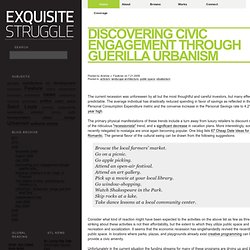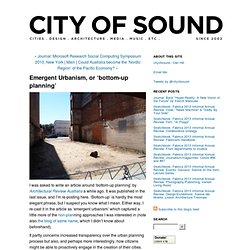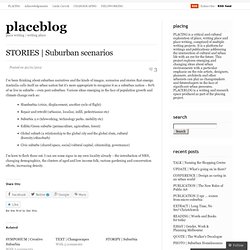

Integrating Urbanisms & New Suburban Typologies - Carl Giometti, Miami University (Oxford, Ohio). Architecture Dept. The World Today - No land home sale hopes 25/05/2010. ELEANOR HALL: While Indigenous communities negotiate on the long term lease issue with the Federal Government, in the capital cities a similar solution is being proposed to deal with the affordability concerns.

It is the community land trust. These trusts, which exist in the United States, allow people to buy and sell homes while the land remains held by a non-profit community organisation. The supporters of the latest trust say they want to address "middle-class exclusion" and are targeting some of Australia's most expensive suburbs as Michael Vincent reports. MICHAEL VINCENT: Bondi Beach is one of Australia's most sought after locations. It can cost hundreds of dollars to rent there and millions of dollars to buy.
Daily Sprawl: Retrofitting Suburban Sprawl... Ultimate Suburban Survivalist Guide by Sean Brodrick. The Culture Now Project: Empower the Periphery. Shapingsuburbia. Benefits - shapingsuburbia. For making the changes proposed by Shaping Suburbia, and yes, the benefits to the city of course benefit us all too.

LAND OWNER PROPERTY VALUES INCREASE from their current levels. The nature of increasing the livability of the suburbs opens up development opportunities. in addition to the development opportunities, there is uplift in the value of regenerated areas. Click here to refer to financial section. Rebar Art & Design Studio. Discovering civic engagement through guerilla urbanism @ Exquisite Struggle. The current recession was unforeseen by all but the most thoughtful and careful investors, but many effects of the recession are predictable.

The average individual has drastically reduced spending in favor of savings as reflected in the downward spike of the Personal Consumption Expenditure metric and the converse increase in the Personal Savings rate to 4.2%; this rate marks an 11 year high. The primary physical manifestations of these trends include a turn away from luxury retailers to discount superstores, the emergence of the ridiculous "recessionista" trend, and a significant decrease in vacation plans.
More interestingly, some cultural pastimes recently relegated to nostalgia are once again becoming popular. One blog lists 67 Cheap Date Ideas for the Recession-Era Romantic. The general flavor of the cultural swing can be drawn from the following suggestions: CMG:Crack Garden. Emergent Urbanism, or ‘bottom-up planning’
I was asked to write an article around ‘bottom-up planning’ by Architectural Review Australia a while ago.

It was published in the last issue, and I’m re-posting here. ‘Bottom-up’ is hardly the most elegant phrase, but I suspect you know what I mean. Either way, I re-cast it in the article as ‘emergent urbanism’ which captured a little more of the non-planning approaches I was interested in (note also the blog of same name, which I didn’t know about beforehand). It partly concerns increased transparency over the urban planning process but also, and perhaps more interestingly, how citizens might be able to proactively engage in the creation of their cities. While it applies to Australian cities most closely, I hope the ideas here might be more generally interesting. And for those of you outside Australia, there are a few subtitles required to read this. Rebar Art & Design Studio. Suburban scenarios « placeblog. I’ve been thinking about suburban narratives and the kinds of images, scenarios and stories that emerge.

Australia calls itself an urban nation but it’s more appropriate to recognise it as a suburban nation – 80% of us live in suburbs – even post-suburban. Various ideas emerging in the face of population growth and climate change such as: Slumburbia (crisis, displacement, another cycle of flight)Repair and retrofit (urbanise, localise, infill, pedestrianise etc)Suburbia 2.0 (teleworking, technology parks. mobility etc)Edible/Green suburbs (permaculture, agriculture, forest)Global suburb (a relationship to the global city and the global slum, cultural diversity/ethnoburb)Civic suburbs (shared space, social/cultural capital, citizenship, governance) I’m keen to flesh these out.
I can see some signs in my own locality already – the introduction of NBN, changing demographics, the clusters of aged and low income folk, various gardening and conservation efforts, increasing density. Like this: Adaptable Suburbs. A study of the relationship between networks of human activity and the changing form of urban and suburban centres through time The project closing conference will take place on 28 April 2014.

If you wish to attend please go to our Closing Conference page for further information. The UK’s suburbs are overlooked and poorly understood. The word ‘suburb’ betrays their perceived status as places that are subordinate to the centre. Urban policy has tended to treat them simply as extensions of towns and cities and as places where nothing changes, rather than as separate entities we can learn from, with their own particular characteristics. UCL’s EPSRC-funded Towards Successful Suburban Town Centres project challenged policy assumptions about suburbs, revealing that they have a great deal to teach us. The current project Adaptable Suburbs is underway. In tough economic times, the era of large-scale, all-encompassing regeneration projects is probably over.
Street Makeovers Put New Spin on the Block - Miller-McCune. How community activists are taking city planning into their own hands and creating pedestrian-friendly blocks via pop-up urbanism.

The recession may have robbed city governments of the wherewithal to enhance public places. But some undaunted architects, planners, and community activists are trying urban design experiments that are deliberately cheap, temporary, and unofficial. And sometimes these modest but audacious interventions lead to altered municipal policies and lasting changes in the cityscape. Take an effort called the Better Block, which launched with an unofficial event in Dallas in April 2010. For one weekend, community activists anted up just under $1,000 and used mostly borrowed materials and their own labor to transform a pedestrian-unfriendly city block in their Oak Cliff neighborhood into what urban designers call a “complete street” — one that doesn’t just serve cars. [youtube]hdZpJ5MwbqA[/youtube] [class name="dont_print_this"] Suburban Transformations ___ Paul Lukez. Enabling Suburbs. ACCESS: the Magazine of UCTC.
Download this article as a pdf.

Renovating the suburbs. Our contemporary urban environments are being shaped by an agenda of sustainable development and steered by a language of resilience.

This is an astonishing shift from the postwar, industrialized narratives that forged the types of buildings and settlement patterns we are familiar with today. To meet the challenges of population growth in a new era of climate change and ecological limits, cities are increasingly being submitted to a program of urban reform. Converting Urban and Suburban Lands for Growing Food. The following is excerpted from The Urban Food Revolution, published by New Society Publishers.

I felt just a little conspicuous walking through the South Side of Chicago; I was the only white person in view since I got off the bus many blocks away. I was headed to Growing Home's Wood Street Urban Farm in the Englewood neighborhood. "You must be going to the garden," a man said to me as I walked past a cluster of friends chilling on a porch a few blocks away from the garden. Ellen Dunham-Jones: Retrofitting suburbia.